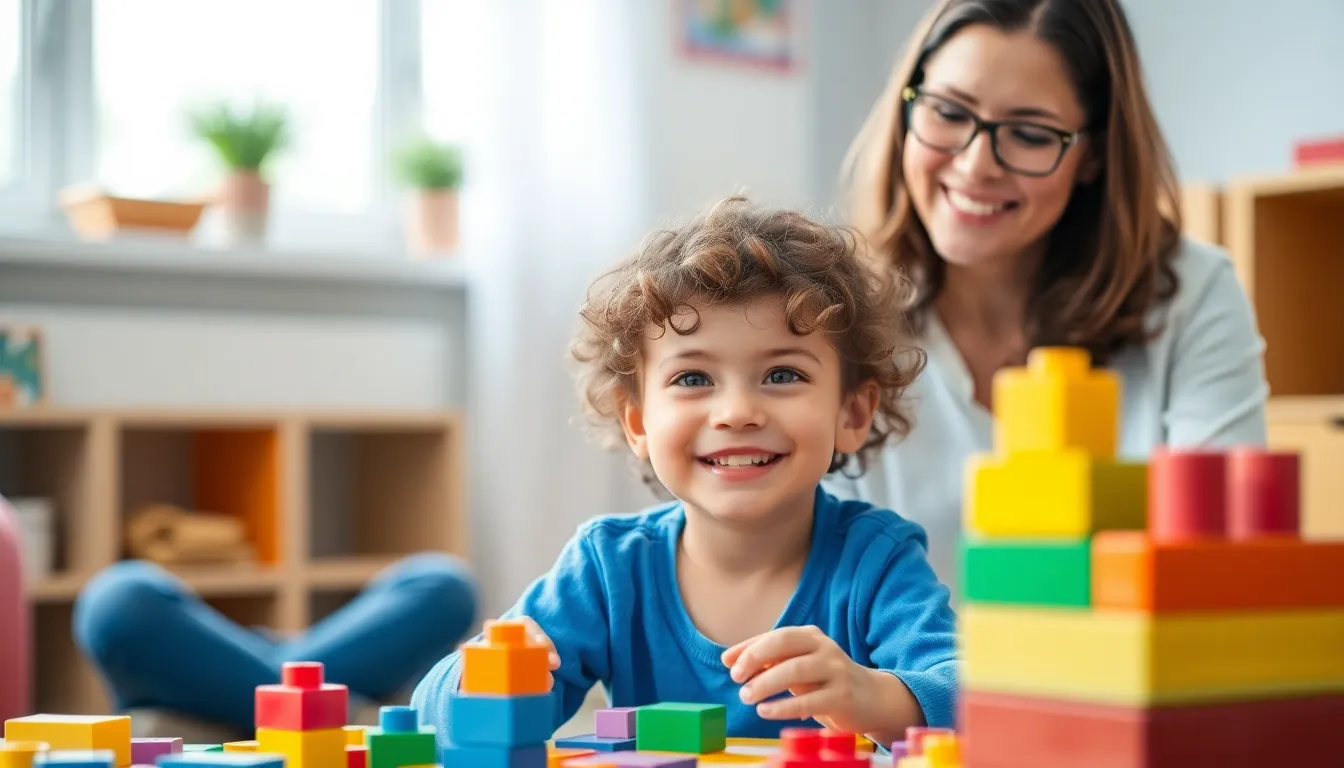Navigating the world of child behavior can feel like trying to solve a Rubik’s Cube blindfolded. One minute they’re giggling over a silly joke, and the next, they’re throwing a tantrum that could rival a Hollywood blockbuster. Enter child behavior therapy, a superhero in disguise that helps kids—and their parents—find balance and harmony.
Table of Contents
ToggleOverview of Child Behavior Therapy
Child behavior therapy targets specific behaviors by encouraging positive change through structured interventions. Techniques deployed include cognitive-behavioral strategies and play therapy, aimed at addressing emotional and social challenges.
Clinicians assess behaviors to develop tailored treatment plans, focusing on individual needs. Sessions may involve role-playing, modeling appropriate behaviors, and reinforcing positive actions. Parents often participate in therapy, equipping them with tools to support their child’s progress.
Behavioral issues may stem from various sources, including trauma, anxiety, and developmental disorders. Identifying these underlying causes proves crucial in formulating effective therapy strategies. Research indicates that early intervention leads to more favorable outcomes, enhancing both emotional and academic skills.
When therapy integrates parental guidance, it fosters consistency between home and therapy environments. Parents learn techniques to reinforce behavior modifications daily, creating a supportive atmosphere for their children. Collaborative efforts ensure that children feel understood and nurtured.
Common issues addressed include attention deficit hyperactivity disorder (ADHD), oppositional defiant disorder (ODD), and anxiety disorders. These conditions often overlap, making thorough evaluations vital in identifying appropriate treatments. Therapists utilize evidence-based practices, ensuring interventions meet clinical standards.
Regular progress assessments allow for modifications, keeping treatment aligned with evolving needs. Engagement in therapy often leads to improved self-esteem and better interpersonal relationships. Overall, child behavior therapy serves as an effective means to nurture growth, resilience, and well-being in children.
Types of Child Behavior Therapy

Various types of child behavior therapy address specific issues children face. These therapies provide structured techniques designed to foster positive changes in behavior and emotional regulation.
Cognitive Behavioral Therapy
Cognitive behavioral therapy (CBT) focuses on the connection between thoughts and feelings. This method helps children identify and challenge negative thought patterns. Therapists provide strategies that guide children in replacing these thoughts with healthier alternatives. Sessions usually include skill-building exercises and practice techniques. Evidence supports CBT as effective for disorders like anxiety and ADHD, leading to improved coping strategies. Skills learned in therapy often extend beyond sessions, empowering children to handle daily challenges.
Play Therapy
Play therapy utilizes play as a means for children to express themselves. Through creative activities, children communicate feelings and experiences they might struggle to articulate verbally. Therapists create a safe environment where children can explore emotions and develop problem-solving skills. This method is particularly beneficial for younger children who feel more comfortable expressing themselves through play. Research demonstrates that play therapy fosters positive emotional and social growth, allowing children to process life events effectively.
Parent-Child Interaction Therapy
Parent-child interaction therapy (PCIT) emphasizes improving the parent-child relationship through active engagement. This approach trains parents in effective discipline techniques and positive reinforcement strategies. Therapists provide real-time coaching during sessions, allowing parents to practice new skills. Focus remains on enhancing communication and reducing behavioral problems. Studies indicate that PCIT leads to significant improvements in child behaviors and enhances parental confidence. Strengthening this bond often results in more harmonious family dynamics, promoting better childhood development.
Techniques Used in Child Behavior Therapy
Child behavior therapy employs various structured techniques to address problematic behaviors effectively. These methods promote positive interactions and emotional regulation in children.
Behavioral Modification Techniques
Behavioral modification techniques target specific behaviors through consistent strategies. Clinicians often use applied behavior analysis to identify behaviors requiring change. They then implement interventions, such as setting clear expectations and providing regular feedback. Monitoring behavior helps professionals assess progress and adjust strategies as needed. Techniques like time-out can discipline effectively, while reinforcing compliance through praise encourages desired behaviors. Regular assessments provide insight into ongoing adjustments required in treatment plans.
Positive Reinforcement Strategies
Positive reinforcement strategies play a crucial role in encouraging desired behaviors. By rewarding children for specific actions, therapists create a motivating environment. This approach emphasizes praise, tokens, or privileges as incentives for good behavior. Celebrating small wins fosters confidence and builds self-esteem, leading to further positive actions. Establishing a system for tracking achievements encourages consistency, creating a routine that children understand. Engaging parents in reinforcement practices at home ensures continuity and supports overall progress in therapy.
Benefits of Child Behavior Therapy
Child behavior therapy offers numerous advantages for both children and their families. Improved emotional regulation emerges as children learn to identify and manage their feelings. They gain essential coping strategies that enhance their overall emotional health. Greater self-esteem develops as kids experience success in addressing their behavioral challenges.
Enhanced social skills become evident as therapy encourages healthy interactions with peers. Children practice effective communication techniques in controlled environments, fostering positive relationships. Stronger parent-child relationships materialize when parents engage in the therapy process. They learn techniques that improve discipline and enhance communication, leading to more harmonious family dynamics.
Children also exhibit better academic performance as therapy supports emotional and behavioral regulation. Academic challenges often stem from unregulated behaviors, so addressing them can lead to greater focus and engagement in school. Therapeutic techniques, like cognitive-behavioral strategies, empower kids to challenge negative thought patterns, enabling improved performance.
Therapy provides early intervention, which is crucial for addressing issues like ADHD and anxiety disorders. Research indicates that timely support significantly impacts long-term emotional stability and developmental success. Regular assessments permit clinicians to track progress and adjust treatment plans, ensuring adaptive strategies that meet children’s evolving needs.
Lastly, a focus on resilience is inherent in child behavior therapy. Skill-building not only targets current issues but also equips children with tools to face future challenges. By fostering emotional growth and self-awareness, therapy prepares them for the complexities of adulthood. Overall, child behavior therapy serves as a valuable resource for promoting well-being and positive development.
Considerations and Limitations
Child behavior therapy offers numerous benefits, yet certain considerations and limitations exist. Various factors impact treatment success, including the child’s age and developmental stage. Clinicians assess these elements to tailor approaches accordingly.
Differences in individual responses to therapy often arise due to unique personalities and backgrounds. Parents should remain realistic regarding expected outcomes. Progress may occur gradually, and setbacks are common. Open communication with the therapist fosters a better understanding of these dynamics.
Some limitations involve access to qualified therapists, particularly in underserved areas. Availability of resources can restrict the frequency and duration of sessions. Additionally, parental involvement can vary; not all parents engage equally or are willing to participate.
Cultural factors play a significant role in shaping perceptions of therapy. Families from diverse backgrounds may hold differing views on mental health, influencing their willingness to seek help. Effective therapy often necessitates cultural competence among practitioners.
Insurance coverage presents another challenge. Some plans may not fully cover child behavior therapy, resulting in financial strain for families. Awareness of coverage options and advocacy for necessary services might help mitigate these issues.
Time constraints also impact therapy effectiveness. Scheduling conflicts between school, work, and therapy appointments can hinder consistent attendance. Establishing a structured routine enhances stability and maximizes therapeutic benefits.
Recognizing these considerations and limitations is essential for families embarking on therapy journeys. Acknowledging potential challenges enables families to prepare adequately and increases the likelihood of positive outcomes.
Child behavior therapy stands as a vital tool for addressing the complexities of children’s emotional and behavioral challenges. By employing structured techniques and engaging parents in the therapeutic process, it fosters lasting positive changes in both children and families. The benefits extend beyond immediate behavior modification, enhancing emotional regulation and social skills while strengthening family dynamics.
As families navigate the journey of therapy, understanding the potential challenges and maintaining realistic expectations can significantly impact outcomes. With early intervention and the right support, children can develop resilience and the necessary skills to thrive in various aspects of their lives. Embracing this therapeutic approach can lead to a brighter future filled with growth and well-being.




